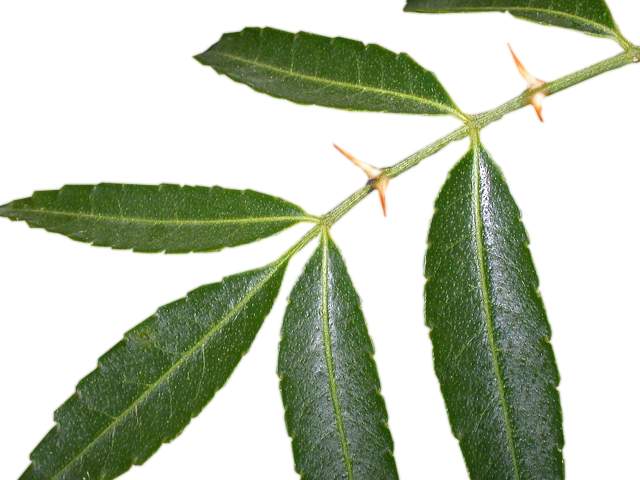- Fagara coco
status = Secure
regnum =Plantae
unranked_divisio =Angiosperms
unranked_classis =Eudicots
unranked_ordo =Rosids
ordo =Sapindales
familia =Rutaceae
genus = "Zanthoxylum " or "Fagara"
species = "F. coco"
binomial = "Fagara coco"
binomial_authority = (Gill.) Engl. & Prant|"Fagara coco" or "Zanthoxylum coco" is an evergreen tree of the
Rutaceae family, natural ofArgentina andBolivia where it grows in the wild, mostly hilly, spinniferous forests. Its natural habitat ranges the hilly forest of Sierras PampeanasDescription
The coco, also "cochucho" or "smelly sauco", is usually found either in isolated groups or standing alone. It's a small to medium sized tree, ranging 6 to 8 m high. The folliage is abundant,
evergreen withimparipinnate leafs that present paired spines presumably in the place of leaflets. Punctations, in pairs, on the leaflets are quite notable. Leafs have serrated margins and pinnate venation. Flowers have fivepetal s and are arranged in panicular inflorescences. The fruit is spheric shaped, dehiscent; containing a shiny blackish seed. [Stucker, G.V.: (1930), Contribución al estudio del Fagara coco, Congreso Internacional de Biología, Montevideo, Oct. 1930.] The whole plant has a characteristic unpleasant smell; there comes "smelly sauco" as another common name. [Fernández Rua, R.: (1933), El alcaloide de la corteza del Fagara coco: la fagaridina, Córdoba, folleto - 12 pp. y tablas.]Biochemistry
Even though unused in general botanical pharmacopea, "Fagara coco" tissues are very rich in
alkaloids .Fagarine , N-methil-iso-coridine, eskimminianine, a-fagarine, fagarine-2, magnoflorinne, nitidine, cheleritrinne,berberine ,palmatine andcandicine have been isolated from folliage and wood. [Boelcke, O.: (1989) Plantas vasculares de la Argentina - Bs.As., Ed. H. Sur, 2da. reimpresión, 171 - 369 pp.]Taxon synonym usage
The "coco" belongs to the "
Zanthoxylum " genus. However, most local scientific articles use "Fagara" as the genus of choice. "Fagara" and "Zanthoxylum" are equivalent synonyms.References
* Hieronymus, G.: (1882), Plantae Diaphoricae Florae Argentinae - Bs. A.s, Ed. Kraft, 53 - 404 pp.
* Domínguez, J. A.: (1928), Contribuciones a la Materia Médica Argentina, Bs. As., Ed. Peuser, 95 - 433 pp.
* Stucker, G.V.: (1930), Contribución al estudio del Fagara coco, Congreso Internacional de Biología, Montevideo, Oct. 1930.
* Fernández Rua, R.: (1933), El alcaloide de la corteza del Fagara coco: la fagaridina, Córdoba, folleto - 12 pp. y tablas.
* Boelcke, O.: (1989) Plantas vasculares de la Argentina - Bs.As., Ed. H. Sur, 2da. reimpresión, 171 - 369 pp.
Wikimedia Foundation. 2010.

